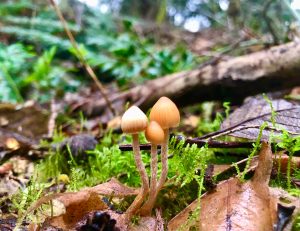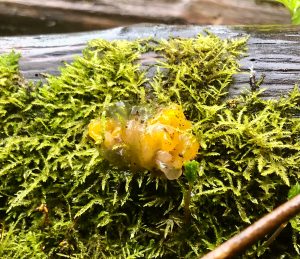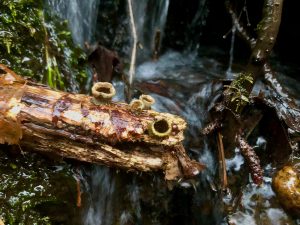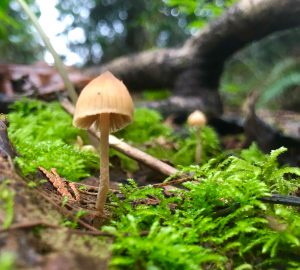
Graeme Hughes
Graeme Hughes is currently completing his Bachelor of Arts with a Major in Psychology at Capilano University. He has appeared on Capilano University’s Dean’s List multiple times, and has been recognized as a Pacwest and CCAA National Champion during his time on Capilano University’s men’s volleyball team. He plans to attend Vancouver Island University to study in their Psychedelic-Assisted Therapy Graduate Certificate Program, and eventually become a psychedelic integration therapist.
As our world is becoming more accepting of unconventional forms of medicine, stigma concerning the medical use of psychedelics is slowly lifting. With continuous positive results in research, microdosing may be the future of mental health care. Canada is currently in a state that has been referred to as a psychedelic renaissance (Lu, 2021). As there has been a paradigm shift in attitudes and legality surrounding the clinical use of psychedelics, Canada has the potential to be at the forefront of new treatments for mental health. While psychedelic-assisted therapy has been growing in popularity because of its success in treating symptoms of depression, anxiety, PTST, addiction, eating disorders and more; Some practitioners have shifted their view towards microdosing psychedelics because it may be able to offer similar benefits to psychedelic-assisted therapy procedures.
I first became aware of psychedelic-assisted therapy when researching for an assignment three years ago. The assignment was on alternative treatments for depression, and I was drawn to psychedelic-assisted therapy because of the remarkably high rates of remission when treating depression. Over the last year I have been doing a lot of thinking and research of what field of psychology I wanted to pursue, and my deep interest in psychedelic research has led me to want to pursue a career as a psychedelic-integrated therapist. What led me to the topic of microdosing is how the research is so new, and how promising research findings are. Because this research is so new, the medical use of psychedelics is mysterious, there is so much that is unknown, and so much to learn. In this article I will explore the potential mental health benefits that can be gained from microdosing (with a focus on psilocybin) and arguing that there is a need for more research. This article will begin with an explanation of what microdosing is, and how it relates to psychedelic-assisted therapy. Following that explanation, will be an interview with a medical expert who is an active researcher in the field. Throughout the article I will be referencing the interview while I will be engaging with similar research, and literature on microdosing. Beginning with discussing some of her findings, followed by potential setbacks, and ending with predictions for the future. Current research suggests that microdosing psychedelics has been found to increase mental health, mood, and psychomotor ability, because of this there is a need for more research to be conducted so these benefits can be utilized by practitioners.
Psilocybin is a psychedelic compound that can be found naturally in some species of fungus and will be the focus of this article, as is commonly used in microdosing research. Consumption of a full-sized dose of this psychoactive substance can cause auditory and visual hallucinations, as well as deep introspection. In a psychedelic-assisted therapy session participants will typically take a full dose of a psychedelic and will be guided through their experience by a trained therapist. The effects of full doses of psychedelics have been researched in-depth, and findings have led to the understanding that psychedelic drugs like psilocybin, LSD, and ketamine can have profound therapeutic benefits (Anderson, et al., 2019). These therapeutic benefits have led psychedelic-assisted therapy to become an increasingly popular treatment because of its ability to yield positive results and surprisingly low remission rates. While the action of taking a full dose (enough to elicit a hallucinogenic response) of a psychedelic substance is referred to as a macrodose, microdosing refers to the practice of consuming a sub-hallucinogenic, low dose of a psychedelic substance (Anderson, et al., 2019).
In the interest of not impairing cognitive functioning, micro-dosages can be as small as 0.1-0.3 grams, and are usually around one tenth the size of a full dose (Wellborn 2022). They are typically self-administered and are taken once every three to four days and can be taken over a short or prolonged period of time (Wellborn 2022. Factors that draw practitioners toward the prospect of microdosing include its safety, and the fact that it has potential to be a hands-off alternative to current psychedelic-assisted therapy practices. As patients are taking a fraction of the substance used in a psychedelic-assisted therapy session, they are not taking enough to become intoxicated and can go about their daily life. In doing so there are hopes that these microdosers will get similar benefits to those that are taking part in psychedelic therapy sessions.
I had the pleasure of interviewing Dr. Pamela Kryskow to gain insight from a medical expert and active microdosing researcher. Kryskow is a trailblazer in modern psychedelic research, she is a medical doctor, a founding board member of the Psychedelic Association of Canada, the medical lead of the Non-Profit Roots To Thrive Psychedelic Assisted Therapy Programs, as well as the medical chair of the Vancouver Island University Graduate Certificate in Psychedelic-assisted Therapy. Kryskow is also a co-investigator on Microdose.me, where she is studying the effects microdosing has on mood, mental health, and psychomotor ability (Rootman, et al., 2022).

Dr. Pamela Kryskow is a medical doctor, medical chair of the Vancouver Island University Post Graduate Certificate in Psychedelic-assisted therapy, and is involved with researching a number of psychoactive substances. (photo from Vancouver Island University, n.d.)
When discussing some of the potential positive outcomes of microdosing, Kryskow highlighted findings from the Microdose.me study that show great promise in microdosing’s ability to positively impact people.
“We published twice in Natural Scientific Reports, and in those, what we found was that depression looks like it goes down, anxiety looks like it goes down, people that have negative moods tend to have less negative moods, people tend to have more positive thoughts. We also found that 55-year-olds, people that are 55 and older, who are using ‘The Stamets Stack’ which is psilocybin, niacin and lion’s mane mycelium, they seem to get faster, their reaction time gets faster, their tap tests get faster.”
In current research there is a focus on microdosing’s ability to help negative symptoms associated with depression, anxiety, low mood, but are also testing for factors like physical ability. As this research is in its early days, there are a lot of unknowns, because of this researchers are using a lot of metrics in their research to gain a more robust depth of information. Speaking of the Microdose.me study, Kryskow elaborated:
We ask people: what are you doing, why are you doing it, how old are you, where are you from, what is your ethnicity, what are you hoping to get from it, why are you doing it, and then seeing if people are doing it. So what we did in the microdose.me app, the study, is that we put validated studies in there. So, normal validated studies that I do as a physician in my office, so questionnaires to see what people’s mood is, their anxiety, their depression, whether they have a lot of positive moods, negative moods, well-being, creativity, visual tests, hearing, reaction time, memory, and stuff like that. So we put all of the validated tests that we could find into microdose.me to see what is actually happening. So, all of the research that we have is based on that, based on what people are telling us and then going through these validated studies.
Being able to test for so many different metrics allows researchers to understand what areas may be influenced and what areas may not, this can help refine future research and get more in-depth results.

As magic mushrooms are not currently legal in Canada, Please enjoy these magical photos of mushrooms found growing in the wild in B.C.
Elaborating on the tap-test Kryskow noted “The tap test is a test that is used at the doctor’s office to get a sense of what people’s reaction time with diseases, with neurodegenerative diseases such as Alzheimer’s, Parkinson’s, MS, different ataxias.”, Increased scores on this metric especially in later life imply that microdosing psychedelics may have further medical uses potentially for the treatment of neurodegenerative diseases. Though this is by no means proven, further speculation suggests that further research of microdosing on people struggling with these diseases may lead to new treatments and in turn help people who are struggling. Explaining conclusions made from this research Kryskow affirms that because this is an observational study, there is a need for further clinical trials.
“So that test we were able to put in our study, [Speaking of the tap test] … there has to be a clinical trial to prove it of course, you always have to say that because it is just an observational study, is it looks like people that are on The Stamets Stack [which is psilocybin, niacin and lion’s mane mycelium] get faster in their reaction time. You know that is really promising because there is not really much you see that people that get older, get better.”
It is noted that there is a need for further clinical trials. These trials can help develop the growing research around microdosing, and more specifically can target exactly what effects that different substances can have when microdosing. As well, evidence toward the capability for microdosing to help dexterity in people who are 55 years old and up outlines how versatile of a treatment this can be.

This is a small cluster of Coral Spring Mycena, they can be found in damp and mossy places. They are a native species to B.C.
Kryskow’s findings are published in the article: Psilocybin microdosers demonstrate greater observed improvements in mood and mental health at one month relative to non-microdosing controls. Kryskow and colleagues collected longitudinal data from between November 2019, and May 2021, and gained participants through self-selected respondents drawn from the Microdose.me study (Rootman, et al., 2022). Participants were given baseline assessments before, and a follow up assessment after a 22-35 day period (Rootman, et al., 2022). In these assessments participants’ mood, depression, anxiety and psychomotor skills were evaluated (Rootman, et al., 2022). Participants were placed in groups corresponding to their condition, these groups include non-microdosers in between the ages 18-55, non-microdosers 55 and older, 18-55 year olds microdosing psilocybin, people 55 and older microdosing psilocybin, 18-55 year olds microdosing a mixture of psilocybin, lion’s mane, and niacin, and people 55 and older microdosing a mixture of Psilocybin, lion’s mane, and niacin (Rootman, et al., 2022). As discussed earlier, findings are consistent with similar, and previous research hinting towards an association between those who participated in microdosing and an increase in mood, mental well-being, and psychomotor ability.
Suggesting similar benefits, research conducted by Anderson, Farb, et al. (2019), titled Microdosing psychedelics: Personality, mental health, and creative differences in microdosers. Anderson, Farb, et al. (2019), had participants engage in self-report measures that assessed their dysfunctional attitudes, wisdom, negative emotionality, open-mindedness, and mood. This study was made to investigate possible connections between microdosing psychedelics and cognitive benefits. Consistent with the findings of Rootman, et al. (2022), participants reported having lower levels of dysfunctional attitudes, negative emotionality, and higher levels of open-mindedness, and creativity (Anderson, Farb, et al., 2019).

This mushroom is a Witches’ butter, an edible group of mushrooms that can be found in B.C. Interestingly enough the term witches’ butter refers to a group of similar mushrooms that are very difficult to tell apart by eye.
When asked if she had experienced any setbacks in psychedelic research, Dr. Kryskow had an interesting response.
“I do not think there are any setbacks, it is a slow process because when you are doing a clinical trial, which we are doing, you just have to go much slower because it is all about patient safety.”
In trials where participants are administering their own doses, safety is the most important factor. Especially when substances, if the incorrect dosage is taken, can result in an altered state of consciousness and functional impairment. If participants were to take a dosage that is larger than prescribed, and go on about their daily lives, they could put themselves and others at risk when doing tasks like driving or operating machinery. As an important safety measure Health Canada must approve of any psychedelic therapy trials and requires that rapport between clinical trial participants and therapist is critical, there are good manufacturing practices in the psychedelic that is being used in the trial and risk-management measures (Government of Canada). Though these measures are necessary for patient safety, they can take a lot of time, and not allow researchers to conduct their research as fast as they may be able to. With that said, patient safety and ethics is an extremely important part of finding results.

These mushrooms appear to be Bird’s Nest Fungi, a small non-edible fungi that can be found growing on fallen sticks from trees.
Continuing her earlier statement Kryskow stated “In some ways I wish we could move faster because there are so many people microdosing and so many people labelling themselves like microdosing coaches, and they are not regulated people.” As the amount of people microdosing continues to increase, there are bound to be people who are not experts discussing their experiences and opinions online. This begins to create issues when they have a platform to speak on, or others begin to listen to their advice. Because these people are not trained professionals, and their research typically consists of a sample size of one person their research is not generalizable and therefore should not be applied to other people. If they are not properly educated on the subject they are not able to explain and understand safety protocols, they may not be aware if their information is even correct. In other words, they may not know what they are talking about and could be giving terrible advice. Also, as psychedelic substances are not regulated for sale because they are not yet legal, those that are currently microdosing must be extremely careful of where they are getting their psychedelics from. When asked about something that the general public should know about microdosing Dr. Kryskow stated:
“People that are selling are not required to go through any kind of inspection process. The basic inspections that even a good producer has to go through is not what is happening. People have to be really careful and have due diligence and look into things and not be super trusting.”
Without proper education and understanding of how to test their psychedelics, people could be thinking they are taking one substance and taking another. This is a major motivator for the need for more research on microdosing. With a better understanding of psychedelic safety, advancements can be made for regulated means of administration. Those who want to microdose would not have to worry about sketchy distributors or accidentally taking a dangerous substance.
While microdosing research is in very early stages of development, current findings are very promising. Microdosing may become a much more common practice in the near future and leads to questions of what that future might just look like. When asked about this, Kryskow said
“I hope that we are still doing really interesting clinical trials and we are still finding out fantastic information, and we know who it works for, at what dose, at what frequency. … I look forward to the day when we legally can sit there and talk to our patients and our clients and say: hey I think this would be really great for you, and lets try this approach, and see how it works, we will make sure it is working for you and we will do it safely.”
Having a richer understanding of the intricacies of microdosing, like exactly what substance has what effects, what are optimal doses, and what frequency can allow for more efficient and effective use. With a better understanding, more practitioners utilize microdosing as a potential treatment for their patients.

This is another photo of Coral Spring Mycena. These mushrooms can be found on forest floors, growing near moss and tree roots.
Alongside the ability to use microdosing as a medical treatment, Kryskow elaborated on the versatility of its applications.
“I personally hope that we see these come into being, not only for medicines for people who need them, but also maybe medicines for wellness and creativity. … I see it as a vitamin essentially, that it’ll be a health vitamin to help, you know, maintain neurogenesis and to help with our brains, and maybe reaction time. Maybe this will be something that elite athletes use so they have a faster wrist shot, or they have a higher jump shot, or maybe they are just way more in the zone on a downhill ski race. I think these things are going to come back that way, I mean we are seeing it already in the real world. People are using them, and they are reporting these benefits, but then we’ll also disambiguate who it’s not for. I think that’s equally important, is saying: oh, who is it safe for and who should not use it.”
If microdosing research continues to display that microdosing psychedelics is safe, and has positive outcomes, more people will be able to use them to improve aspects of their lives. It is also apparent that a lot of different groups of people would be able to benefit from their effects.
Considering the application and the good that microdosing may be able to bring to people’s lives Dr. Kryskow shared “For some people this could change their lives remarkably. That is what medicine is about, making it so the patients don’t need us anymore. Helping people find their wellness and their health again, that’s the whole reason you go into medicine.” Current research still has far to go, but it is undeniable that research regarding microdosing psychedelics has unbelievable potential.
References
Anderson, T., Christopher, A., Dinh-Williams, L., Hapke, E., Hui, K., Petranker, R., Rosenbaum, D., & Weissman, C. Psychedelic microdosing benefits and challenges: an empirical codebook. Harm Reduct J 16, 43 (2019). https://doi.org/10.1186/s12954-019-0308-4
Anderson, T., Petranker, R., Rosenbaum, D., Weissman, C. R., Dinh-Williams, L.-A., Hui, K., Hapke, E., & Farb, N. A. S. (2019). Microdosing psychedelics: personality, mental health, and creativity differences in microdosers. Psychopharmacology, 236(2), 731–740.
Andersson, M., Kjellgren, A. Twenty percent better with 20 micrograms? A qualitative study of psychedelic microdosing self-rapports and discussions on YouTube. Harm Reduct J 16, 63 (2019). https://doi.org/10.1186/s12954-019-0333-3
Government of Canada. (2022, December 5). Government of Canada. Canada.ca. Retrieved March 28, 2023, from https://www.canada.ca/en/health-canada/services/drugs-health-products/drug-products/announcements/expectations-risk-management-measures-clinical-trials-psychedelic-assisted-psychotherapy.html
Lu, D. (2021, September 25). ‘psychedelics Renaissance’: New wave of research puts hallucinogenics forward to treat mental health. The Guardian. Retrieved March 21, 2023, from https://www.theguardian.com/society/2021/sep/26/psychedelics-renaissance-new-wave-of-research-puts-hallucinogenics-forward-to-treat-mental-health
Rootman, J. M., Kiraga, M., Kryskow, P., Harvey, K., Stamets, P., Santos-Brault, E., Kuypers, K. P., & Walsh, Z. (2022). Psilocybin microdosers demonstrate greater observed improvements in mood and mental health at one month relative to non-microdosing controls. Scientific Reports, 12(1). https://doi.org/10.1038/s41598-022-14512-3
Vancouver Island University (n.d.) Dr. Pamela Kryskow https://research.viu.ca/ncpr/kryskow-dr-pamela
Wellborn, P. (2022, July 11). Psychedelic mushroom microdoses can improve mood, mental health. UBC Okanagan News. Retrieved March 16, 2023, from https://news.ok.ubc.ca/2022/07/11/psychedelic-mushroom-microdoses-can-improve-mood-mental-health/
